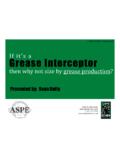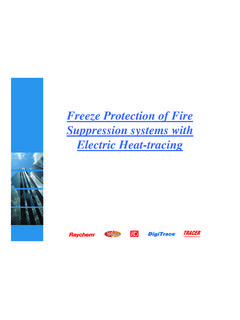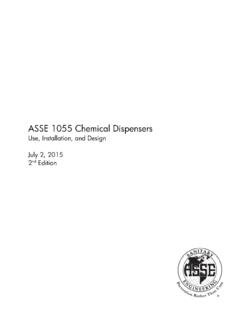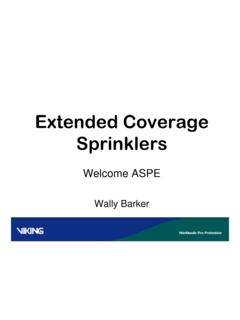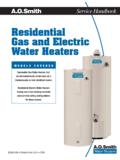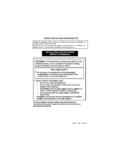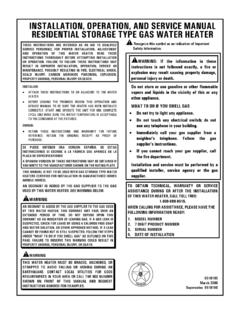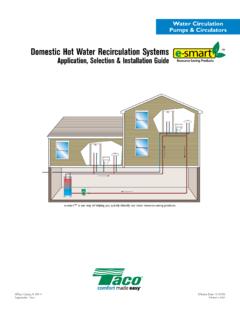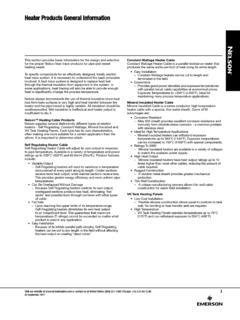Transcription of Understanding Potential Water Heater Scald Hazards
1 Understanding Potential Water Heater Scald Hazards A White Paper Developed by the American Society of Sanitary Engineering Scald Awareness Task Group PUBLISHED: March 2012. ASSE International Office - 901 Canterbury Road, Suite A - Westlake, Ohio 44145. re Pr en Cu ev ti o n Phone: - Fax: - Web Site: n R ath er T ha . Contents Contents 2. Section 1 Executive Summary 3. Section 2 Purpose 4. Section 3 The Problem 5. Section 4 Examples of the Problem 6. Section 5 Health Related Concerns 7. Section 6 Solutions to the Problem 8. Section 7 Definitions 9. Section 8 Tables, Graphs & Graphics: 11. Table 1 Estimated Time & Temperature Effects on Adult Skin 11. Figure 1 Water Temperature Effects on Legionellae Bacteria 12. Figure 2 Water Temperature vs Scald Potential 13. Section 9 Task Group Members 14. 2 Understanding Potential Water Heater Scald Hazards Section 1.
2 Executive Summary The American Society of Sanitary Engineering (ASSE) Scald Awareness Task Group was formed to educate and give guidance to the general public and plumbing industry on scalding Hazards associated with hot Water at the point of use. This White Paper focuses on one aspect of the hot Water delivery system: the thermostat setting at the Water Heater . Improper design and use of hot Water delivery systems can lead to scalding and other health and safety related effects. There is a general misconception that the Water Heater thermostatic control is capable of delivering a constant, safe Water temperature. Temperatures at the point of use over 120 degrees F (49 degrees C). are considered a hazard. Without further temperature controlling downstream of the outlet of the Water Heater , the Potential to experience dangerous scalding Water temperatures at the point of use increases greatly.
3 There are confirmed instances of health Hazards when storing domestic hot Water for human use and/or contact at temperatures known to sustain growth of harmful bacteria. The storage temperature in a tank type Water Heater should be at least 135 to 140 degrees F (57 to 60 degrees C) to minimize the growth of harmful bacteria normally present in the Scald injuries can be prevented by following these guidelines: Be Aware: Understand the risks of scalding. Be Proactive: Always test the Water to ensure a safe temperature. Be Responsible: Have a qualified service person or plumbing engineer make an assessment of your potable hot Water heating and delivery system to see if one or more of these devices are applicable: Temperature actuated mixing valve Automatic compensating mixing valve Temperature limiting device Scald injuries caused by excessive hot Water temperatures at the point of use are minimized by following the recommendations provided in this White Paper.
4 1. American Society of Plumbing Engineers Position paper, May 6, 1989, and ASHRAE Guideline 12-2000, para. Understanding Potential Water Heater Scald Hazards 3. Section 2. Purpose The ASSE Scald Awareness Task Group was formed to educate and give guidance to the general public and plumbing industry on the many ways that someone can be exposed to the Potential scalding Hazards associated with domestic hot Water at the point of use. This White Paper focuses on one way that this exposure can occur: relying only on the thermostat setting at the Water Heater as the primary Water temperature control at the point of use. Many people have the misconception that the Water Heater thermostatic control is capable of delivering a constant, consistent Water temperature. This paper addresses why this misconception can create a false sense of security, and more importantly, details how scalding and thermal shock can be avoided and how to control the final point of use temperature.
5 The majority of Scald injuries caused by excessive hot Water temperatures at the points of use should be eliminated by using the recommendations in Section 6 - The Solutions. Recommendations for lowering the Water Heater thermostatic control setting have reduced the risk of Scald injuries, but have not fully solved the 2. Tap Water Scald Prevention: Its Time for a Worldwide Effort; Katcher ML, Injury Prevention 1998:4;167-169. 4 Understanding Potential Water Heater Scald Hazards Section 3. The Problem Storage type Water heaters have been used in domestic applications since the early 1900s. Since this time, Water Heater technology has continued to improve to the present day and is a reliable source of hot Water in almost every home. However, as a large Water storage device, there are technology limits to the precision of Water temperature control. Water heaters alone cannot accurately control the hot Water temperature at the point-of-use.
6 For example, without specific technical knowledge of how the Water Heater operates and failure to review operating instructions, the specifier, installer and consumer may assume that the Water Heater can control the Water temperature with the same precision that the thermostat for the heating and air conditioning system controls the temperature in the home. This misconception has led many users and operators to set the Water Heater thermostatic control at 120. degrees F (49 degrees C) and incorrectly assume that the Water temperature will not exceed this value. However, temperatures over 120 degrees F (49 degrees C) at the points of use are considered a hazard, with extremely higher temperatures causing serious second and third-degree Scald burns upon contact with adult skin. Since the Water Heater thermostatic control is typically located at the bottom of the Water Heater , it does not sense the Water temperature at the upper outlet of the Water Heater .
7 Without further temperature controlling downstream of the outlet of the Water Heater , there is Potential to experience hot Water temperatures at the point of use that pose a Scald hazard. For this purpose, most Water Heater manufacturers and various plumbing codes3 require that the Water Heater thermostatic control should never be used to control the final temperature of the Water to the point of use. 3. International Plumbing Code; International Residential Code; Uniform Plumbing Code Understanding Potential Water Heater Scald Hazards 5. Section 4. Examples of the Problem EXAMPLE 1: It is well known and documented that you cannot control the upper outlet temperature of a Water Heater with its manually adjustable thermostatic control. Just physically turning down the Water Heater thermostatic control will not eliminate the risk of scalding temperatures since the Water Heater thermostatic control is not accurate enough to prevent these scalding temperatures.
8 Also, the Water Heater thermostatic control does not address pressure imbalances in the hot and/or cold Water distribution system, which have been known to cause thermal shock when a non-compensating type shower or tub/shower combination valve has been installed and/or replaced. Most model plumbing codes require automatic compensating type shower valves that comply with ASSE 1016/ASME , which have pressure, temperature, or pressure and temperature compensating elements and a maximum temperature limiting stop, which can limit the hot Water temperature coming from the shower valve to minimize the risk of scalding in showers and/or tub/shower combinations. These model codes also prohibit the Water Heater thermostatic control from being used as the final control of the Water temperature. Unfortunately, there are some jurisdictions which allow exceptions to these code requirements.
9 Such an exception will allow anyone to install a non-automatic compensating type shower or tub/shower combination valve, which cannot and will not prevent thermal shock or scalding. EXAMPLE 2: A person hears about scalding dangers associated with Water heaters on a handy man talk show where the host recommends turning down the Water Heater thermostatic control to prevent scalding. This person then decides to set the Water Heater thermostatic control at the 120 degrees F (49 degrees C) setting as recommended. It is possible for the household to experience multiple intermittent short draws of hot Water usage, whereby cold Water gets introduced at the bottom of the Water Heater and then causes the thermostatic control to sense the cold Water , which turns the burner on. When this intermittent usage occurs within a relatively short time period, it causes overheating of the upper Water at the top of the Heater .
10 This is referred to as thermal layering or stacking or stratification. This thermal layering can result in hot Water temperatures in excess of 140 degrees F (60 degrees C) at the top of storage type Water heaters . When the Water Heater is in a stacking condition and where there is extremely hot Water at the top of the Water Heater , a person gets into the shower and physically adjusts a non-compensating shower valve to a comfortable bathing temperature. Unexpectedly, the temperature could suddenly spike to a scalding temperature when someone else in the house uses cold Water while the shower is running. Water at an extreme scalding temperature may cause irreversible third-degree burn injuries instantly upon contact with the skin. It is for this reason the model plumbing codes have added language mandating that the thermostatic control on the Water Heater not be used as the final temperature control to prevent scalding and thermal shock.
